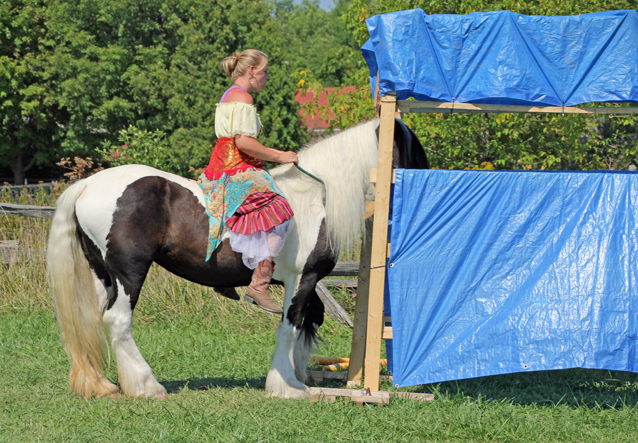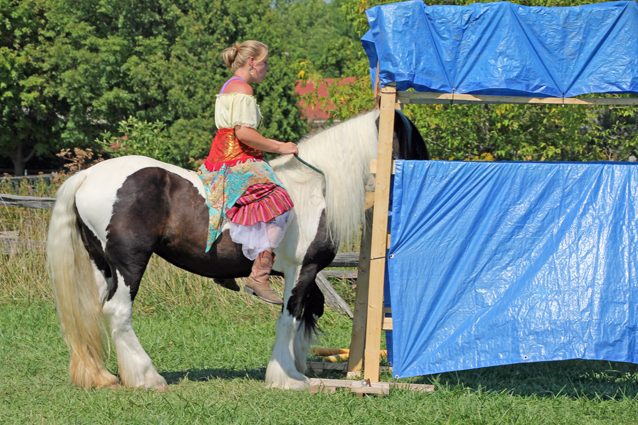
CFN – This Column of “Spirits in Unity” is being published by CFN for the community of Stormont, Dundas & Glengarry.
Ready, Set, Go
Getting your horse ready for what you want to do is what it is all about.
One of the biggest problem areas in handling horses is with trailer loading. Now there are probably as many ways of getting a horse onto a trailer as there are horses. A lot of these ways includes tricks that can force a horse into the trailer, but to get him to want to load is the real goal.
Trailer loading is actually not about the trailer but an issue of confidence. By asking a horse to do small challenges then proceed to something bigger and then more and more challenging until finally the trailer doesn’t seem that big an issue because we have proven to the horse that we can be trusted and we’ve built his confidence in himself, in us and in his environment. This can be accomplished in a variety of ways that involve asking him to approach obstacles or objects that bother him or to do movements that mimic the movements of getting in the trailer. Every time we ask the horse to do something, we are checking how ready he is and we don’t go to the next step until we have got it.
Here are the steps I try to follow:
First I try to show the horse that I care. I try to consider his physical state first. But also I try to be aware of his emotional and mental state as well. Once I am sure that there are no care issues my next goal is to get control. Because people know that I believe in what is sometimes referred to as natural horsemanship, they often think that I don’t control my horses. Actually control is key. But control doesn’t have to mean cruelty. I know that there are a lot of gimmicks out there designed to control horses, but I prefer to get control by first understanding the true personality of the horse that I am dealing with.
Control techniques should be tailored to the particular type of individual with which you are working. A one size fits all solution doesn’t work very effectively. Sure, you may be lucky that the method you have chosen works for the horse you have at hand, but it doesn’t mean that the method will work equally effectively for the next horse.
Horses come in different personality types. Right Brain Extroverts, Right Brain Introverts, Left Brain Introverts, and Left-Brain Extroverts.
Right-Brain Extroverts – These are the horses that are quick to panic. To help him snap out of his panic attack you need to interrupt the pattern of behaviour and concentrate on getting him to disengage his hindquarters, turn and face you and respect your personal space.
Right-Brain Introverts – With these horses the keys is doing nothing, following the horse around, and mirroring him. Dealing with this type of personality can be very demanding for the handler, because it will seem that everything you are doing is the exact opposite of what your instincts are telling you to do.
Left-Brain Introverts – with this type of horse it is important to go very slowly and concentrate on moving his front end a lot.
Left-Brain Extroverts – With these types of personality it is important to encourage his play drive and keep things provocative and interesting.
Second – Develop a language of communication between you and the horse. Allow and encourage him to be curious. Progressively allow the horse to approach obstacles but don’t force it. Try to watch for when the confidence comes through. When they show you that they are ready then ask them to try. Reward the slightest try with total release. The old cowboy saying that goes, “Don’t ask a galloping horse to gallop” applies.
Third – Try to get the horse to accomplish slightly more advanced manoeuvres such as backing, slowing the horse down by wiggling the lead rope, circling him around objects and keeping him moving, going sideways, squeezing between objects, walking over tarps, jumping over barrels.
Fourth – Ask for progressively more challenging things such as getting him to put his foot on things, accepting a ball on his back, jumping barrels with speed, squeezing past the trailer ramp.
Finally – When the horse becomes calm, confident, motivated and willing and curious about the inside of the trailer, encourage him to step inside.
On average it takes about an hour and a half to two hours because it is not about getting him in the trailer as quickly as possible. You never know how long it is going to take to gain a horse’s trust and confidence, but it is important not to push them. If you push when he is not ready, it will diminish his confidence. Every time you diminish his confidence instead of building it, you are going backwards.
It is not about the trailer. It is about the relationship you are building with your horse. When we build his self-confidence and help him be more confident in our relationship and his environment and when we ask the right question at the right time, he is going to say yes instead of no. And if it is the wrong time, we’ll just prepare more and then try again later.
With anything you want your horse to do, don’t tell him to do it, ask him if he’s ready. Then it will take nothing more than a suggestion from you. And one day just a thought. Remarkably this works for human students too.
Remember that in any training session you are always preparing the road for the next session.
It takes patience and persistence sometimes, but the rewards are very satisfying.
Be sure to click on the ‘like’ or ‘dislike’ buttons to let us know that you have read today’s column. It is an honour to have you as a reader. I welcome any comments, questions or topics you would like me to discuss. I hope you enjoy reading about the wonderful world of horses and the impact that natural horsemanship can have in making it a better world for both horses and humans?
In our ‘Spirits in Unity’ program we believe in developing a trusting relationship and a true partnership with a horse before even thinking about getting on his back. He probably prefers it that way too.
Whether you are just a horse lover, have dreams of owning a horse someday, or already have one, I hope these columns will give you some insight into the true nature of these magnificent creatures. I hope you will find them both informative and inspirational.
Until next time…
May all your dreams come true,
Garry “Horsetalker” Meek

